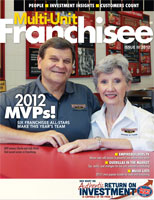The Sponge Technique: Squeeze The Balance Sheet to Improve Cash Flow
Everyone knows the value of a sponge: it absorbs water. This is a pretty good deal. Well, your company's balance sheet is just like a sponge--except that it soaks up cash instead of water. This is not necessarily a good financial deal. As a sponge nears its capacity to absorb additional water, it becomes increasingly less efficient. The same thing occurs with your balance sheet, a phenomenon that has two basic causes.
Increasing sales--or growth--creates a need for additional money to finance an increased level of assets. As we have noted before, the main source for most companies is from creditors--in other words, debt. Risk (in the form of increased debt) increases accordingly, and increasing interest expense may even put downward pressure on profits.
Furthermore, growth in sales is often accompanied by a decrease in the efficiency of operation. This inefficiency really surfaces on the balance sheet as proportionally more assets are required to support new sales levels. In other words, the rate of asset growth increases faster than sales; you make the same percent of profit--but you make it less efficiently.
So what do you do? From my perspective, the clear message in a growth situation is straightforward: manage better. I've listed a few of the ways that can be done:
- Manage current assets (inventory, A/R) more efficiently
- Restructure debt (long term, not short term)
- Make more profit
- Sell existing unproductive assets
- Curtail expansion
- Lease fixed assets
- Implement sale-leaseback of existing fixed assets
- Accept more risk (i.e., more debt)
- Don't grow (use pricing, etc. to limit growth)
- Get new equity--a passive investor or active partner
This list represents the action steps necessary to manage growth effectively. You need to arrive at the particular combination of components that will work for you. Remember, when it comes to the balance sheet, doing "nothing" is usually the worst possible decision.
By earning the same level of profits more efficiently, sufficient cash is "squeezed out" of the balance sheet to significantly reduce the borrowing requirements.
Consequently, this concept that we've labeled "Financial Gap" can be applied two ways. First, it's effective as a tool to estimate borrowing needs in a growth situation--at an existing level of asset management efficiency. More important, it's an indispensable management planning tool for developing goals and standards of performance for efficient management. Keep in mind that there are three fundamental parameters in evaluating the growth capabilities of expanding companies:
- How efficient the company is now.
- The financial requirements of a particular company; that is, what new assets will be needed.
- The owner's abilities as an "asset manager"--strong or weak.
Growth is reflected on the profit-and-loss statement as increases in sales and (hopefully) profits. The "cost of growth" is generally reflected on the balance sheet in the form of increased debt to offset decreased efficiency.
These are controllable issues. If you choose not to control them, then your banker may choose to "help." This help will come in the form of restrictive covenants regarding asset management; that is, turnover requirements for inventory and/or accounts receivable. (Listen for the comment: "I'm doing this for your own good!")
What they're really saying is that borrowing implies a partnership: you supply efficient management and your banker will supply sufficient funds. Banks are in business to finance efficient growth, not to subsidize your inefficiency.
The sponge analogy? Well, efficiency translates to squeezing your balance sheet to free up the funds you need to grow. Otherwise, you'll find it squeezing you.
Steve LeFever is the founder and chairman of Profit Mastery, a Seattle-based eLearning company that has trained more than half a million people on how to measure and manage financial information to consistently increase business profits. Their programs have been taught around the globe and are now available online as an on-demand video program that can be accessed 24/7/365. Learn more about this educational course at www.profitmastery.net. or contact him at 800-488-3520 x14 or [email protected].
Share this Feature
Recommended Reading:
FRANCHISE TOPICS
- Multi-Unit Franchising
- Get Started in Franchising
- Franchise Growth
- Franchise Operations
- Open New Units
- Franchise Leadership
- Franchise Marketing
- Technology
- Franchise Law
- Franchise Awards
- Franchise Rankings
- Franchise Trends
- Franchise Development
- Featured Franchise Stories
FEATURED IN

Multi-Unit Franchisee Magazine: Issue 3, 2012

$100,000
$250,000





 The multi-unit franchise opportunities listed above are not related to or endorsed by Multi-Unit Franchisee or Franchise Update Media Group. We are not engaged in, supporting, or endorsing any specific franchise, business opportunity, company or individual. No statement in this site is to be construed as a recommendation. We encourage prospective franchise buyers to perform extensive due diligence when considering a franchise opportunity.
The multi-unit franchise opportunities listed above are not related to or endorsed by Multi-Unit Franchisee or Franchise Update Media Group. We are not engaged in, supporting, or endorsing any specific franchise, business opportunity, company or individual. No statement in this site is to be construed as a recommendation. We encourage prospective franchise buyers to perform extensive due diligence when considering a franchise opportunity.